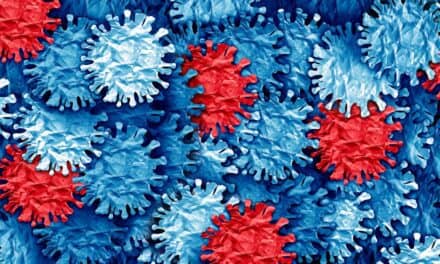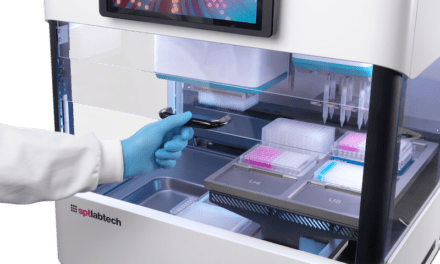By Craig S. Hill, PhD

Nucleic acid amplification tests (NAAT) for infectious diseases have come into widespread use in many clinical microbiology laboratories in recent years. A number of these tests have been commercialized and approved by the FDA for testing for infectious disease organisms in clinical samples. These tests have had a major impact on clinical laboratory diagnostics due to the higher sensitivity of NAAT compared to conventional tests and the ability of NAAT to detect organisms that are difficult or impossible to culture.
The Need for Automation
Although initial or first-generation NAATs generally have excellent performance, many clinical laboratories have been slow to adopt the tests because of higher reagent costs, increased labor requirements, and fear of carryover contamination problems. Larger laboratories envision additional difficulties with NAAT due to the relatively low throughput of many of the test systems and, therefore, the requirement for multiple instruments to handle large test volumes. Some of the current first-generation NAATs have been partially automated in an attempt to reduce the tests’ complexity and labor requirements. Most of the semiautomated tests automate the amplification and detection steps of the assay, but not the sample-processing step, which is typically the most troublesome step in NAAT. First-generation NAAT specimen processing procedures are labor intensive, often requiring centrifugation and numerous manual pipetting steps. First-generation sample processing methods were not designed to effectively remove inhibitory or interfering substances from clinical specimens, but the presence of such substances can cause inhibition of the amplification reaction resulting in false-negative results. Many first-generation NAATs require the use of controls for specimen inhibition that increase costs and lead to repeat testing if the controls fail. Manual sample processing steps also can lead to specimen cross-contamination, resulting in false-positive results and invalid runs.
The manual nature of first-generation NAATs has a direct impact on laboratory costs. These costs include the addition of highly skilled operators needed to run the assays, repeats following questionable results due to quality control, contamination, or inhibition problems, and potential for repetitive-motion injuries from manual pipetting. The complex nature of first-generation NAAT often requires laboratories to assign their more experienced and highly paid technologists to run the tests. The ongoing shortage of laboratory personnel has made it particularly difficult for laboratories to dedicate additional resources to perform NAAT. Run failure, contamination, and inhibition problems can lead to higher costs due to repetition of questionable results that not only reduces efficiency, but also causes delays in reporting results. Patient callbacks to obtain repeat samples are particularly costly. Repetitive motion injuries, such as carpal tunnel syndrome, can occur due to manual pipetting and result in major costs to the laboratory due to absenteeism and workers’ compensation settlements.
The TIGRIS DTS Instrument System: The First Fully-Automated Instrument for NAAT
Full assay automation and improved specimen processing were needed to overcome the problems associated with first-generation NAAT. In response, Gen-Probe developed the first fully automated, high-throughput instrument for NAAT: the TIGRIS® DTS™ system. This instrument has been designed to automate all steps of NAAT: sample processing, amplification, and detection. The TIGRIS DTS system has a throughput of 100 tests per hour following a 3.5 hour time-to-first-result. Specimen bar-code reading allows automatic work list creation from samples randomly loaded onto the carousel, which, when combined with LIS communications, allows positive sample identification and increased overall testing efficiency. The TIGRIS DTS was cleared by the FDA in December 2003 for use with the Gen-Probe APTIMA COMBO 2 (AC2) assay for the detection of Chlamydia trachomatis (CT) and Neisseria gonorrhoeae (GC) in male and female urogenital or urine samples. The AC2 assay is a multiplex NAAT that detects and differentiates both organisms simultaneously in the same reaction tube.

The AC2 assay is the first of several infectious disease NAAT planned for the TIGRIS DTS system. AC2 is a second-generation NAAT utilizing five Gen-Probe proprietary technologies: ribosomal RNA (rRNA) targeting, direct specimen tube sampling via a penetrable cap, target capture specimen processing, transcription-mediated amplification (TMA), and dual kinetic assay (DKA) detection technology. Combining these technologies has removed key barriers associated with first-generation NAAT and made AC2 the only second-generation NAAT available to clinical laboratories. Samples are processed by target capture technology to extract and purify rRNA target molecules from specimen matrices. The CT and GC rRNA targets are coamplified using TMA in a single-reaction well and then simultaneously detected and identified with DKA detection. No repeat testing of positive samples is needed to identify which of the target organisms is present.
Target capture specimen processing has been designed to reduce false-negatives by removing the inhibitors present in the sample by purification of the nucleic acid target prior to amplification. Controls for specimen inhibition are not needed, reducing reagent costs and sample repeat rates. Target capture simplifies sample processing and makes automation easier due to the absence of centrifugation and other complex steps required in most of the first generation, semiautomated NAAT. Swab and urine samples are processed identically, allowing samples to be run together in the same work list. The AC2 assay also utilizes a new sample transport system incorporating a penetrable cap. The system processes specimens from closed tubes, eliminating the cap and swab removal steps. Elimination of these steps resolves major time and labor issues for operators and helps reduce the likelihood of cross-contamination. False-negatives due to inhibition have been documented in published studies to be reduced or eliminated using target-capture technology.
The AC2 assay on the TIGRIS DTS instrument has been designed to address many of the drawbacks of first-generation, semiautomated NAAT, such as complexity, increased labor, and high cost. The only sample preparation required is to load the specimens directly into the system. With minimal sample handling and the use of penetrable caps, the risk of cross-contamination is reduced, as shown in recent clinical studies. There also are no manual pipetting steps or other repetitive-motion tasks, greatly reducing the risk of repetitive-motion injuries. These sample handling improvements also reduce operator variability, leading to more accurate results and less repeat testing. Paperwork also is reduced since the TIGRIS DTS system automatically prints result reports documenting kit reagent lot numbers used. Full automation reduces overall labor requirements and allows technologists to be freed up to work on other laboratory tasks while the TIGRIS DTS is running. In addition, the multiplex technology of AC2 allows two results to be obtained with each test, which effectively reduces the number of tubes processed by up to 50% and increases the results output of each run. Taken together, these system design features greatly improve test performance and reduce laboratory costs.
Implementation of the TIGRIS DTS System in a Large Clinical Diagnostic Laboratory
The TIGRIS DTS system was recently introduced into the Kaiser Permanente Regional Reference Laboratory in North Hollywood, Calif. A comparison study was performed with the AC2 assay on the TIGRIS DTS system compared with the semiautomated DTS 1600 system that the lab had been using for routine testing. The laboratory was running approximately 1,100 CT/GC samples per day, of which 86% were endocervical swab samples and 14% were urine samples from both males and females. Approximately 8,000 samples were run in the AC2 assay on both instruments for the comparison study. Excellent correlation was found between the two systems.
Labor and overall costs were greatly reduced with the implementation of the TIGRIS DTS system. The number of full-time equivalents (FTE) required to staff the TIGRIS was reduced nearly 50%. Total 5-year projected labor savings were calculated to be over $700,000. This savings offsets the higher cost of the TIGRIS DTS compared to the DTS 1600 system. Not included in the calculations were potential cost savings due to repetitive-motion injuries, which can be substantial, with nonsurgical treatment of carpal tunnel syndrome averaging $3,500. Surgical treatment can increase this amount to $20,000. Long-term disability costs can reach $100,000 or more.
Conclusion
The second-generation AC2 assay for CT and GC has many advantages over first-generation NAAT. Design features, such as direct tube sampling, target capture specimen processing, and multiplex amplification and detection technologies, result in increased assay accuracy and efficiency. In addition, full automation of the AC2 assay on the TIGRIS DTS system produces highly accurate results at lower costs than comparable semiautomated systems. Several new infectious disease NAATs are being developed for the TIGRIS DTS system, including a triplex NAAT for HIV-1, hepatitis B (HBV), and hepatitis C (HCV) viruses for use in blood screening.
Nucleic acid amplification testing has the potential to revolutionize not only infectious disease testing, but also many other areas of clinical testing in the fields of genetics, cancer, and other chronic human diseases. Although new FDA-approved NAATs are becoming available, many clinical laboratories have difficulty implementing the tests due to the high labor requirements, contamination concerns, and inhibition problems of the first generation tests. Larger laboratories are particularly hindered by the relatively high labor requirements and low throughput of many of the NAAT systems. New, fully-automated instruments, such as the TIGRIS DTS system, alleviate these constraints by increasing test throughput and decreasing labor requirements, thus reducing the overall costs of NAAT. Full automation also reduces the risk of human error and contributes to increased accuracy of results. Second-generation, fully-automated technologies are making NAAT a reality for more clinical laboratories, leading to improvements in health care through more accurate, rapid, and cost-efficient diagnostic tests.
Craig S. Hill, PhD, is manager of scientific affairs for Gen-Probe.





